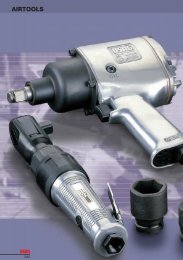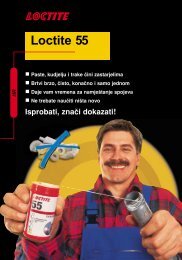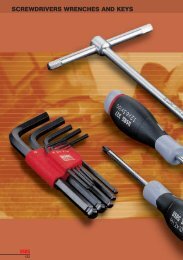Industrial seal self study guide - SKF.com
Industrial seal self study guide - SKF.com
Industrial seal self study guide - SKF.com
You also want an ePaper? Increase the reach of your titles
YUMPU automatically turns print PDFs into web optimized ePapers that Google loves.
V-Ring excludes contaminants,<br />
prevents them from entering<br />
bearing cavity (fig. 4a).<br />
Non-spring-loaded HM <strong>seal</strong> is a<br />
cost-effective design for grease<br />
retention. Note that the lip faces the<br />
lube in this application (fig. 4b).<br />
Chapter 4—<br />
Seal Applications<br />
Seal Selection by Application<br />
When selecting a <strong>seal</strong> for a specific application, it is important to know<br />
what the <strong>seal</strong> is supposed to do and what operating conditions are<br />
present. Common types of applications and <strong>seal</strong> designs re<strong>com</strong>mended<br />
for them are covered below.<br />
Seals for Contaminant Exclusion<br />
In steel mill or work roll applications, an abundance of contaminants—<br />
scale, water spray, abrasive particles—are usually present. The <strong>seal</strong>’s<br />
primary function is to exclude contaminants and prevent them from<br />
entering the bearing cavity.<br />
A back-up excluder <strong>seal</strong>, such as a V-Ring, is re<strong>com</strong>mended (fig 4a).<br />
The V-Ring can function as the primary <strong>seal</strong> or, in applications where<br />
there is excessive contamination, it can provide protection for the<br />
primary <strong>seal</strong>ing element, increasing its life and reliability.<br />
The V-Ring is designed to exclude dust, mud, water and most<br />
contaminants, and can handle pressures up to 10 psi/.07 MPa (static)<br />
or 3-5 psi/.02-.03MPa (dynamic). An all-rubber design, it stretches (up<br />
to 2-1/2 times its diameter) over the shaft, easing installation.<br />
As the <strong>seal</strong> rotates with the shaft, centrifugal force provides a “flinger”<br />
effect, keeping out dust, mud, water and most contaminants. Exclusion<br />
<strong>seal</strong>s can be installed axially against any suitable counterface (bearing,<br />
other <strong>seal</strong>, pillow block, bearing assembly or other housing). They<br />
generally do not require lube for normal operating conditions.<br />
Seals for Grease Retention<br />
Grease lubricated applications, such as electric motors or small trailer<br />
wheels, are generally easier to <strong>seal</strong> than oil lubricated applications.<br />
When cost is also a factor, a non-spring loaded <strong>seal</strong> such as an HM<br />
design, is usually the most cost-effective design for grease retention.<br />
(fig. 4b).<br />
The HM <strong>seal</strong> design retains grease at shaft speeds up to 2000 fpm,<br />
(10.16 m/s) and handles pressure up to 3 psi/.02 MPa. It should be<br />
installed with the lip facing the grease, except in applications where<br />
grease purge is desired. In “purge”-type applications, the lip should<br />
face away from the grease lube.<br />
In grease retention applications where contaminants are present,<br />
a V-Ring can also be installed as a back-up excluder.<br />
32







